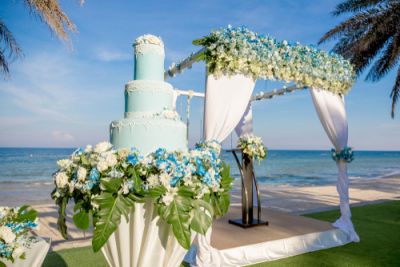 You’ve charged your wedding cake baker with producing a masterpiece, a towering treat festooned with sugary sensational details. Except there’s one potential fly in the ointment: you’re getting married in June and in the great outdoors. How do you ensure that your dream dessert doesn’t undergo a meltdown in front of all your guests? Don’t overlook a few vital planning tips.
You’ve charged your wedding cake baker with producing a masterpiece, a towering treat festooned with sugary sensational details. Except there’s one potential fly in the ointment: you’re getting married in June and in the great outdoors. How do you ensure that your dream dessert doesn’t undergo a meltdown in front of all your guests? Don’t overlook a few vital planning tips.
Talk Candidly With Your Baker
To help your creative confection stand up in less-than-ideal conditions, you’ll need to enlist your baker’s help. A February 2015 Brides article lists several details that you should tell the professional at your consultation and tasting:
- The lighting you’ll use at your reception venue
- The types of decorations you plan to have
- Your wedding colors and linens
- Ceiling height, if applicable
- The temperature in your reception space
All these factors should guide your final cake design. Based on this information, your baker may recommend specific styles, icing types, and colors to help your dessert last throughout your celebration. Your vendor will also take extra precautions for its storage, transport, and setup.
Fondant or Buttercream: Which Is Better?
Buttercream icing is a top choice in terms of flavor, but it may not hold up in the summertime heat. Sadly, most varieties tend to melt in higher temperatures. However, Martha Stewart Weddings writer Alyssa Brown reveals that Italian meringue buttercream has a lower sugar content and a more stable constitution. If your heart’s set on its creamy goodness, ask your baker if the Italian meringue version is available.
Meanwhile, Wedding Wire’s Kim Forrest shares expert advice offered by several bakers across the country. Some swear by the full-bodied stiffness of fondant for when the mercury rises, but they still caution that subtle air pockets in the icing can form as the wedding cake slowly reaches room temperature. Others advise selecting ivory or pale neutral colors for icing and décor and avoiding chocolate, which can melt rapidly during hot weather. One professional pointed out that naked cakes can be more summer-friendly since there’s no exterior frosting to melt or attract insects.
Keep Your Wedding Cake Cool When Temperatures Soar
Martha Stewart Weddings' Alyssa Brown mentions more useful tips to prevent a wedding cake disaster in the great outdoors. Your event timeline is critical to ensure its optimal temperature, freshness, and firmness while cutting and serving. As you plan, be sure to determine the approximate time that you’ll cut the cake during your reception. Your baker will use this to schedule an ideal window for transport and setup.
Furthermore, your sweet centerpiece must be housed in a shaded area. As sunlight shifts during daylight hours, its angle and position will change. Scope out your venue and avoid placing your cake table in a location with direct sun exposure. A shady table is ideal, but you may wish to store your confection indoors if you can’t set it up in a cool spot.
Finally, flexibility is also key to maximize your and your guests’ satisfaction. Should the forecast fail to predict an unforeseen heatwave, consider cutting your cake at an earlier time during your reception. You’ll avoid losing hundreds of dollars on a ruined dessert that no one can eat.
Craft a Game Plan for Your Summer Wedding Cake
Summer is still a favorite time during which couples say “I do.” The natural grandeur of outdoor venues is one common reason for this season’s popularity, but additional precautions should be taken to keep you and your guests happy. Safeguarding the look, taste, and freshness of your wedding cake will take some work and advanced preparations, but the results will be well worth your efforts. Carefully selected ingredients, a shady location, and cutting at peak times are important steps for optimal consistency and flavor.
Add Your Comment